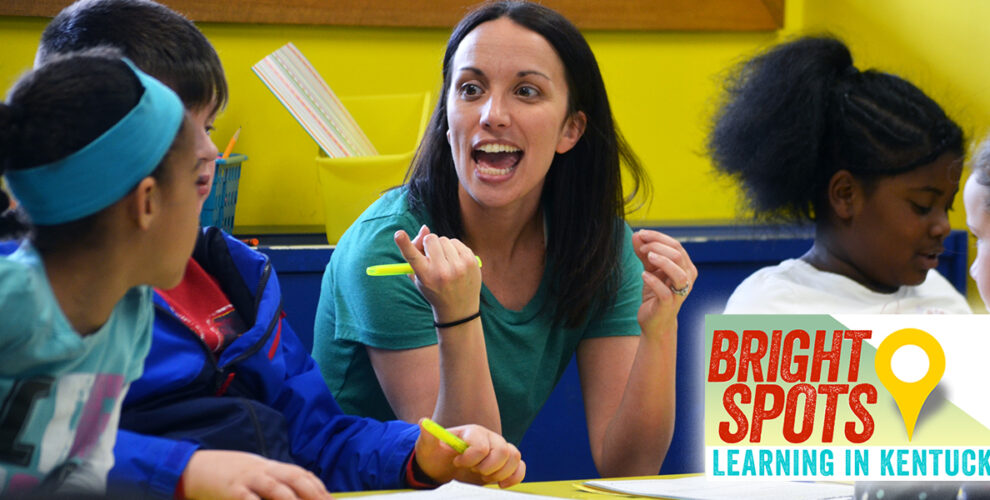RELATIONSHIPS SPARK ACADEMIC MOMENTUM

UPDATE: In November 2020, South Heights Elementary was one of 28 elementary schools across Kentucky identified through research by the Center for Business and Economic Research at the University of Kentucky. The analysis, sponsored by the Prichard Committee, was created to spotlight schools that significantly exceeded expectations based on demographic factors between 2012 and 2019. This profile of the school was published prior to the research project.
_______________
JULY 2018 \ SOUTH HEIGHTS ELEMENTARY in HENDERSONLast summer, when Lydia Burnette of Henderson was thinking ahead to fifth grade at South Heights Elementary, she was called in for a special assignment: Casually loiter in the school lobby. Then, when candidates for an open teaching job appeared, approach, welcome them, start chatting, and pay attention.“We want a teacher who loves students,” Lydia explained. “There’s an inner feeling you get when you have a conversation about whether someone knows how to connect with kids — you want it to be a positive little bubble.”Riley Robinson, a recent college grad seeking her first elementary teaching job, was one of Lydia’s targets who earned high marks.“We had a lovely conversation,” Robinson remembers. “In front of adults, I might clam up. In front of students, I feel relief. I got to the door here, a girl was right there and the questions started. I didn’t experience that in any other interviews.”STUDENTS DISCUSS THEIR WORK during class at South Heights Elementary in Henderson County.South Heights Elementary has built a decidedly student-centered culture over two decades, with test scores rising and achievement gaps shrinking in the process. In a high-poverty neighborhood set against an old industrial district, the school on Madison Street is eager to overcome circumstances or demographics.For starters, the staff of the generic structure on a nondescript street started calling itself “The 1199,” embracing its street address in a show of swagger and pride.The staff pledges to remember each student’s first name within 24 hours or pay up with a free ice cream cone. Teachers recite the school’s motto as “no exceptions, no excuses,” while students are apt to remember the slogan that applies to them: “work hard, play hard.”“Our focus is on culture,” said Rob Carroll, the principal who started at a time the school ranked among the bottom 25 percent on state achievement measures. The turnaround hinged on a deeper bond with students.“You come to school here and you are connected for life,” he said. “Our staff goes to ballgames, high school graduations, helps fill out college financial aid forms, whatever we can do to encourage our kids. Ninety percent may be in poverty, but 100 percent were born to be exceptional. We want them to be academic players in the world.”
Pride is a huge thing. Here, expectations are high and love is abundant.
— Assistant Principal Chris Powers
The school uses its awareness of family issues, out-of-school accomplishments and in-class performance to monitor individual dynamics.Connecting with students begins with daily contact and conversations.One teacher explained how noticing a student’s t-shirt choices revealed the boy’s favorite team. She did homework on the internet to share news and questions about the team, sparking a connection that steadily grew and eased some behavior issues and apathy.“It’s about being real with them,” said Erin Murch, a second- and third-grade English teacher. “We have real conversations with our kids. If there are challenges, we figure out what we are going to do to get through it. They know that we set an expectation and expect them to rise to it.”Camren Vaughn, a fifth grader last year, recalled feeling stumped by long division. “I got used to doing it wrong,” he said, adding that persistent work and encouragement from his teacher helped him turn the corner. “She helped me to remember the right way,” he said. “She was always motivating and telling me to try my best.”In five key demographics used to measure achievement gaps across four tested subjects, South Heights logged proficiency above state averages in all areas and had gaps smaller than the state average in all but two of the 20 measures.Over the past 20 years, South Heights has made steady progress, rising from the bottom 25 percent of Kentucky schools on state tests to near the top 25 percent.
The approach at South Heights has elevated overall performance and made the school a standout in reducing achievement gaps between demographic groups.
On 2017 state tests, the percentage of African American students scoring proficient or above in reading (64 percent) is more than twice the state average (31 percent), with similar performance over the state average in writing and social studies.
Teachers and administrators point to academic efforts like developing a Top 10 list of concepts all students need to master in each subject every year. Planning groups also closely monitor student progress. The focus on relationship building also creates support and unity among the faculty.“We all have that same common ‘why’ for being here — we are all counting on each other to build our students up to change the world,” said Laura Kopshever, the second- and third-grade math teacher and 19-year veteran at South Heights.Academic progress is promoted on many fronts, from regular in-school celebrations to the massive spring musical production designed to involve all third- through fifth-graders. About 75 students usually try out for roles. Practices after school and on weekends lead up to splashy performances at the downtown arts center.“We’ve seen that a lot of our best performers may not be shining academically, which often was because they didn’t see relevance,” Principal Carroll said, adding that engagement in theater often leads to stronger academic dedication.The school takes students in every grade on bigger college tours each year, starting in kindergarten. Pupils who stay all six years will tour Henderson Community College, the University of Evansville across the river, Kentucky Wesleyan in nearby Owensboro, Murray State, the University of Louisville and the University of Kentucky.“We treat them like we treat our own,” Carroll said. “If they are provided access to same experiences and supports we give our own kids, they will succeed. They prove us right every time.”Former student Tanelle Smith, now 23, said that the attention and connection at South Heights propelled her to set ambitious life goals. She graduated from Murray State this spring focused on a career in education.Smith said that encouragement as a reader in kindergarten was the first step in being a confident student. Elementary school was a difficult time as her family moved frequently. The school found ways to keep her from transferring to another school and provided time in the office to deal with family issues.”Sometimes it was hard to focus because we went through so much at home,” Smith remembered. “School was the first time I felt like I could be me and enjoy things I did.” She sang at fifth grade graduation and kept hearing from teachers as she moved to middle school, high school and through college.STUDENTS GATHER FOR A QUICK REVIEW at South Heights Elementary in Henderson.At Murray, her experiences included study abroad in Korea and Belize, a teaching internship in New York City and student teaching in nearby Christian County. The school has stayed in touch throughout. “South Heights comments on my posts all the time,” she said. “It’s amazing to know they’re still in my corner.”Carroll said that Smith’s experience is what the school aspires to. Despite progress, he said, too many students still don’t find a path to meaningful postsecondary study or other preparation for a stable life.Toward that end, South Heights recently helped launch the year-old Audubon Kids Zone, a community-wide effort to concentrate services and programs for families in a high-poverty square-mile area that feeds students to South Heights. Carroll said that it will take stronger community services to launch more students to successful futures.Tammy Sutton directs the program that now operates from two temporary office units in the neighborhood. She said that in addition to new access to after school programs and assistance, the Kids Zone identifies barriers to school success that it can begin to address, like why students from the neighborhood it serves are far less likely to participate in extracurricular programs.Organizers said the reputation of South Heights brought credibility to the Kids Zone, as its longstanding family connections made people welcome the new center.Tanelle Smith said the school’s culture is about wider achievement.“It’s not only student centered, but individually centered,” she said. “A lot of kids are used to hearing what they’re not going to be, what they can’t do, what they’re not good at. After South Heights, I believed that anything I wanted to do, I could accomplish. I felt very important — like somebody who was valued. I wanted to do great because they made me feel like I could reach a higher place.”
\
TOP PHOTO: ERIN MURCH, a second- and third-grade language arts teacher, discusses finding evidence in text and context clues with a small group of students at South Heights Elementary.
ISSUES IN SCHOOL CULTURE
In the 2016 report “Excellence With Equity: It’s Everybody’s Business,” the Prichard Committee called for action to eliminate achievement gaps in Kentucky schools. One of the report’s six key recommendations called for school climate and culture that welcome and support each student and family.Strong connections between teachers and school leaders and the students and family members they serve helps communicate high expectations for learning and make classroom teaching more engaging and relevant to students. A strong school culture focused on achievement — and built to recognize individual student needs — is a key step to high achievement. Some questions that might spark a local conversation:\ How does your school or district define its school culture goals? How are they measured and monitored?\ What should the school culture look like on a daily basis when it comes to teachers’ relationships to students and families? What should families do if those expectations are not being met?\ What do teachers and students say about their ability to form productive relationships and the impact on reaching achievement goals?\ Do local education leaders discuss the connection between achievement gaps and the relationships between schools, teachers and students? What are the plans for making progress?Willard R. Daggett, a former New York State education leader who founded the International Center for Leadership in Education, promotes the importance of “rigor, relevance and relationships” in creating effective schools.Daggett explained the role of strong teacher-student relationships in a 2015 publication: “Teachers must create a learning environment that addresses students’ personal, social, and emotional needs,” he wrote. “The presence of strong relationships between students and teachers builds a trust that positively impacts learning and the learning environment,” he added, noting that research has found significant correlations between strong relationships and increased achievement.Other education leaders and researchers have focused on how student-teacher relationships can improve student motivation and achievement.In the 2016 book, Helping Children Succeed: What Works and Why, author Paul Tough explained the key role teachers can play in motivating students: “When kids feel a sense of belonging at school, when they receive the right kind of messages from an adult who believes they can succeed and who is attending to them with some degree of compassion and respect, they are then more likely to show up to class, to persevere longer at difficult tasks, and to deal more resiliently with the countless small-scale setbacks and frustrations that make up the typical student’s school day,” he wrote.The ASCD, a leading national teaching-and-learning group that started as the Association for Supervision and Curriculum Development, provides various strategies for a whole child approach and the long-term development of students. It focuses on policy and practice to assure students are healthy, safe, engaged, supported and challenged.Each month, the BRIGHT SPOTS blog showcases impressive learning in Kentucky schools.IN AUGUST \ EMPHASIZING MASTERY at Trimble County Junior HighABOUT SOUTH HEIGHTS ELEMENTARY \ENROLLMENT: 530 in K-5KEY DEMOGRAPHICSRACE: 24% minorityINCOME: 90% eligible for free/reduced price mealsDATA NOTES\ In 2017, African American students outperformed white students in reading proficiency on state tests, with 64 percent of African American pupils scoring proficient or above compared to 63 percent of white students. Among Hispanic students, 59 percent scored proficient or better on reading. All groups were above the state average. The data reflects performance by students enrolled in the school for at least 100 days.\ Performance by African American students was more than 20 points above the group’s state average for proficiency in all subjects tested in 2017 — reading, math, social studies and writing. Writing scores for all groups were well above the state average.\ South Heights is not the Henderson County district’s highest-scoring elementary, but its above-average results across achievement gap groups stand out, particularly when compared to statewide performance.




